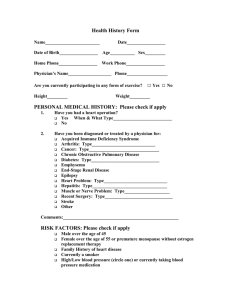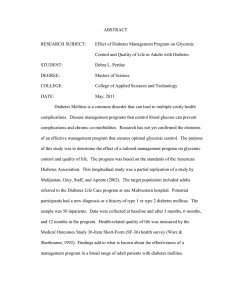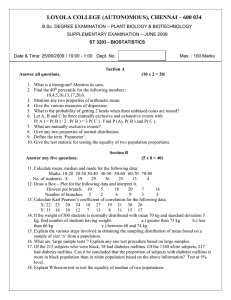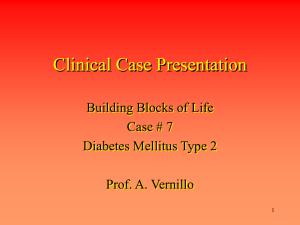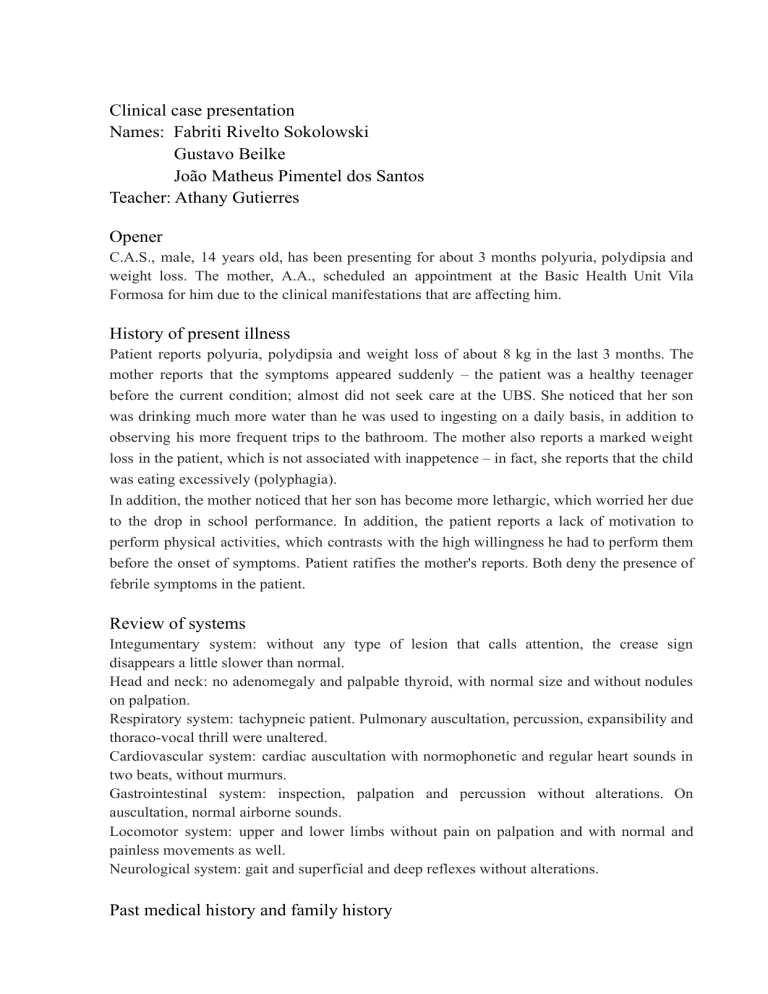
Clinical case presentation Names: Fabriti Rivelto Sokolowski Gustavo Beilke João Matheus Pimentel dos Santos Teacher: Athany Gutierres Opener C.A.S., male, 14 years old, has been presenting for about 3 months polyuria, polydipsia and weight loss. The mother, A.A., scheduled an appointment at the Basic Health Unit Vila Formosa for him due to the clinical manifestations that are affecting him. History of present illness Patient reports polyuria, polydipsia and weight loss of about 8 kg in the last 3 months. The mother reports that the symptoms appeared suddenly – the patient was a healthy teenager before the current condition; almost did not seek care at the UBS. She noticed that her son was drinking much more water than he was used to ingesting on a daily basis, in addition to observing his more frequent trips to the bathroom. The mother also reports a marked weight loss in the patient, which is not associated with inappetence – in fact, she reports that the child was eating excessively (polyphagia). In addition, the mother noticed that her son has become more lethargic, which worried her due to the drop in school performance. In addition, the patient reports a lack of motivation to perform physical activities, which contrasts with the high willingness he had to perform them before the onset of symptoms. Patient ratifies the mother's reports. Both deny the presence of febrile symptoms in the patient. Review of systems Integumentary system: without any type of lesion that calls attention, the crease sign disappears a little slower than normal. Head and neck: no adenomegaly and palpable thyroid, with normal size and without nodules on palpation. Respiratory system: tachypneic patient. Pulmonary auscultation, percussion, expansibility and thoraco-vocal thrill were unaltered. Cardiovascular system: cardiac auscultation with normophonetic and regular heart sounds in two beats, without murmurs. Gastrointestinal system: inspection, palpation and percussion without alterations. On auscultation, normal airborne sounds. Locomotor system: upper and lower limbs without pain on palpation and with normal and painless movements as well. Neurological system: gait and superficial and deep reflexes without alterations. Past medical history and family history He denies previous occurrences of measles, mumps, whooping cough, rubella and parasites. She reported an episode of chickenpox when she was 10 years old, but it resolved well with proper treatment at the time. He denies previous surgeries and hospitalizations. She denies comorbidities and allergies. Vaccination book up to date. She was born at term by normal delivery, without complications. She was breastfed until the age of two. He had normal neuropsychomotor development and growth - his growth curves from the vaccination record are within normal limits. Patient reports inactive sex life. He denies the use of alcohol, cigarettes and other drugs. According to her mother, C.A.S. he was always a smart, intelligent and healthy child, played football at least once a week and always got excellent grades in school. The mother reports that she and the father always offered all educational, emotional and financial support so that the son could dedicate himself to his studies and maintain good life habits. The patient lives in a brick house with basic sanitation and access to treated water in the urban area of the city, with his two parents and his 10-year-old sister. Mother and son report harmonious family dynamics. Regarding family history, the mother and father are alive and have systemic arterial hypertension. Your sister does not have any morbidity. His maternal and paternal grandmothers have type 2 diabetes mellitus. His paternal grandfather is deceased and did not have any chronic disease in life. Her maternal grandfather had type 1 diabetes mellitus and died at age 68. Physical exam Weight: 50 kg; Height: 165 cm; Body Mass Index: 18.37 kg/m² ; Axillary temperature: 36.0°C. Blood pressure: 110×70 mmHg; Heart rate: 95 bpm; Respiratory rate: 18 bpm. On general examination, the patient was in a regular general condition, lucid and oriented in space-time, anicteric, acyanotic, with pale conjunctival mucosa +/4+ and slightly dry oral mucosa and tongue. Capillary filling of upper and lower limbs is normal. Results of lab test, imaging and other diagnostics Fecal parasitological screening was negative, the blood count was normal and the following blood glucose results were obtained: fasting glucose – 143 mg/dl, serum glucose after 2 h of the oral glucose tolerance test – 1.75 g/kg of dextrosol 250 mg/dl and a glycated hemoglobin (HbA1C) – 8.0% Assessment and plan Thus, associating the symptoms presented by the patient together with laboratory findings and family history, it was possible to confirm the diagnosis of type 1B diabetes mellitus, as it was an idiopathic and nonspecific condition. The classification in 1B was due to the fact that the patient was young, healthy, had a normal BMI for his age (18.37 kg/m²) and had cases of the disease in his family. With this, the possibility of being type 2 diabetes mellitus was ruled out, as this form normally affects adults, the elderly and obese patients. According to the Diabetes Mellitus Type 1 Clinical Protocol and Therapeutic Guidelines (BRASIL, 2019), the treatment of people with type 1 diabetes mellitus consists of five main components: diabetes education, insulin therapy, glycemic self-monitoring, nutritional guidance and monitored practice of physical exercise.

